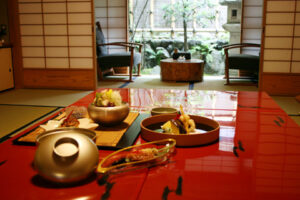 I found this useful information about Japanese Ryokan so I thought I would pass it on.
I found this useful information about Japanese Ryokan so I thought I would pass it on.
A typical ryokan is an Japanese-style inn. Like a Western-style inn, maintaining the special, atmosphere and appearance is more important than providing the latest modern conveniences. A ryokan is for travellers who wish to experience Japanese culture and enjoy the comforts of Japanese hospitality and service.
There are, of course, many different styles of ryokans and the Ryokan Styles post will help explain them.
A Brief History of Japanese Ryokans
Ryokans have been a part of Japanese culture for centuries. Some of the earliest ryokans were (and some still are) located on the Tokaido Highway which connected the capital city of Edo (current day Tokyo) and the Imperial Palace in Kyoto. It was a very busy highway as samurai, traders, and others made their way between the two popular destinations in the country. Ryokans were built to welcome these weary travellers who needed to rest before continuing on their long journey. Some ryokans were very simple and offered extra rooms in their homes for travellers while others were more elaborate and served the higher ranks of the government. In any case the owners worked hard to make their guests feel as welcome as possible as they still do today.
Inside a Ryokan Guest Room
A typical ryokan guest room contains:
- the “agari-kamachi” (after opening the door guests step into this small area and take off their shoes)
- “shoji” (sliding paper doors) which separates the agari-kamachi from the room
- “tatami” mat flooring (reed floor matting)
- low wooden tables
- “zabuton” (sitting cushions)
- futon (sleeping quilts)
- a “tokonoma” (an ornamental alcove built into the wall used for placing flower vases and hanging scrolls)
- an “oshiire” (a closet for futon sleeping quilts)
- an “engawa” (a glass enclosed sitting area separated from the room by a shoji)
Ryokan Buildings
Many ryokans are composed of different buildings such as:
- “Honkan” (original building)
- “Shinkan” or “Bekkan” (secondary or annex buildings)
Experiencing a Ryokan – is it for you?
Staying at a typical ryokan is a traditional Japanese cultural experience, and it is not like staying at a Western-style hotel. For example ryokans do not have central heating and in the winter this means you will be staying in a room with a portable heater (kerosene, gas, electric). While your room may be heated, your private bathroom (if you have one) will probably not have a separate heater. In the summer time, your room may have an air conditioning unit but again your private bathroom (if you have one) will probably not have one. Many ryokan owners wish to preserve the traditional atmosphere of their ryokan, and this means maintaining old fashioned heating systems in order to preserve the traditional architecture, design, and atmosphere of the ryokan. If you prefer to sleep in a double room with twin queen-size beds and have: a full modern bathroom, carpeted rooms, perfect room temperature, insulated silence, the latest high tech gadgets, and every member of the staff speaking fluent English then a ryokan might not be for you. However, if you wish to see, taste, touch, and feel traditional Japanese culture then a night at a typical ryokan is just the thing for you. While most of the staff at ryokans speak very little English, this authenticity adds to the experience. Ryokans are only available in Japan and it is an experience not to be missed.
Prices
Ryokans charge per guests and not per room. The average price of a one night stay at most ryokans is about 15,000 yen per guest plus tax. For example, if there are two of you traveling together, this means a total of 30,000 yen per night plus tax. If you are staying at a ryokan with an “onsen” (hot spring baths), then there is an additional onsen tax of 150 yen per guest per night. The prices of many ryokans range from about 7,000 yen to 110,000 yen per guest plus tax. At a ryokan some of the following factors determining prices are:
- room size
- room location
- room view (a view of a river, a view of a Japanese garden, etc.)
- room facilities (indoor hot spring bath, outdoor hot spring bath, etc.)
- day of the week
- season and holiday season
- number of guests
- meal(s) served and so on
Payment
Your payment will most likely need to be made in cash (Japanese yen) unless otherwise stated. Some ryokans do accept credit card (of course different ryokans accept different credit cards) though Japan is still a cash society so please be prepared to pay your bill in cash. The most widely accepted credit cards are VISA and MasterCard while American Express and others are not accepted as much.